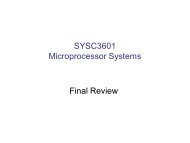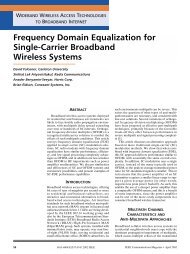Image Reconstruction for 3D Lung Imaging - Department of Systems ...
Image Reconstruction for 3D Lung Imaging - Department of Systems ...
Image Reconstruction for 3D Lung Imaging - Department of Systems ...
Create successful ePaper yourself
Turn your PDF publications into a flip-book with our unique Google optimized e-Paper software.
1. simulated data, generated using a 2D finite element mesh with 1968 elements using the<br />
point electrode model. Data <strong>for</strong> the reference frame was generated using a homogenous<br />
background conductivity with σ0 = 1. The data frame was generated by reducing the<br />
conductivity <strong>of</strong> a single FEM element (0.05% <strong>of</strong> medium area) located halfway along<br />
the radius <strong>of</strong> the tank (r/2) by 15%.<br />
2. simulated data obtained by adding Gaussian noise to set #1. Noise variance was<br />
0.05% <strong>of</strong> maximum signal value, and<br />
3. tank data using a Goe-MF II type tomography system (Viasys Healthcare, Höchberg,<br />
FRG). The reference frame <strong>of</strong> the tank data was generated using a homogenous saline<br />
solution in a 30cm diameter tank. The data frame was generated using a 2cm diameter<br />
non-conductive impulse phantom located at r/2 in the plane <strong>of</strong> the electrodes.<br />
Both simulated and tank data used 16 electrodes equispaced in a plane driven with the<br />
adjacent current drive protocol, excluding data on driven electrodes.<br />
The three data sets were used to reconstruct images using 18 configurations (6 meshes,<br />
3 regularization matrices). The 6 meshes have 64, 256, 492, 576, 1024, and 1968 elements.<br />
<strong>Reconstruction</strong>s <strong>of</strong> simulated data using the 1968 element mesh constituted an inverse crime<br />
[122], which we discuss later. The hyperparameter selection methods are compared using<br />
the L-Curve and Resolution Curves <strong>of</strong> figures 4.5. Hyperparamater values selected from<br />
each <strong>of</strong> the methods are shown on both curves. Associated reconstructions are shown in<br />
figure 4.6.<br />
4.4.2 Heuristic Results<br />
The points on figures 4.5 indicate the first set <strong>of</strong> hyperparameters selected (indirectly)<br />
by heuristic selection. The associated reconstructions are found in figure 4.6. Heuristic<br />
selections varied and were not confined to the minimum region <strong>of</strong> the Resolution Curve or<br />
knee <strong>of</strong> the L-Curve: no clear preference was shown among images reconstructed using λ<br />
from the minimum region <strong>of</strong> the Resolution Curve. The crosses on figures 4.5 indicate the<br />
hyperparameter values selected by the same experts when the experiment was repeated 4<br />
months later. Results indicate that Heuristic selections <strong>of</strong> hyperparameter are inconsistent<br />
among experts and unrepeatable. Heuristic selections are subject to many biases including<br />
the colour scheme used in images, whether impedance changes are shown from a 2D or <strong>3D</strong><br />
perspective, the a priori expectation <strong>of</strong> the expert concerning noise levels, desired image<br />
properties, and other unknown individual idiosyncrasies. The heuristic results suggests that<br />
there is no single preferred value <strong>of</strong> λ, rather there is a preferred region <strong>of</strong> λ over which<br />
reconstructions are not subjectively distinguishable.<br />
4.4.3 L-Curve Results<br />
Although most L-Curves from this data were able to indicate an optimal trade-<strong>of</strong>f region, not<br />
all curves had a pronounced enough corner to allow unambiguous selection <strong>of</strong> λ. In the six<br />
Tikhonov configurations the L-Curve always indicated a clear point <strong>of</strong> maximum curvature.<br />
However there were some configurations, such as figure 4.3(b), where the L-Curve did not<br />
exhibit a corner from which a hyperparameter could be calculated. In general the L-Curve<br />
indicated a lower value <strong>for</strong> λ than the Fixed NF and BestRes methods. As a result L-Curve<br />
derived images were comparatively noisier. In several instances λLC occurred much earlier<br />
than the onset <strong>of</strong> stability. We make the observation that L-Curves <strong>for</strong> the NOSER and<br />
Gaussian HPF priors are shallower than classic L-Curves discussed in the inverse problems<br />
54





